六年级英语上 知识点
六年级英语上册知识点总结
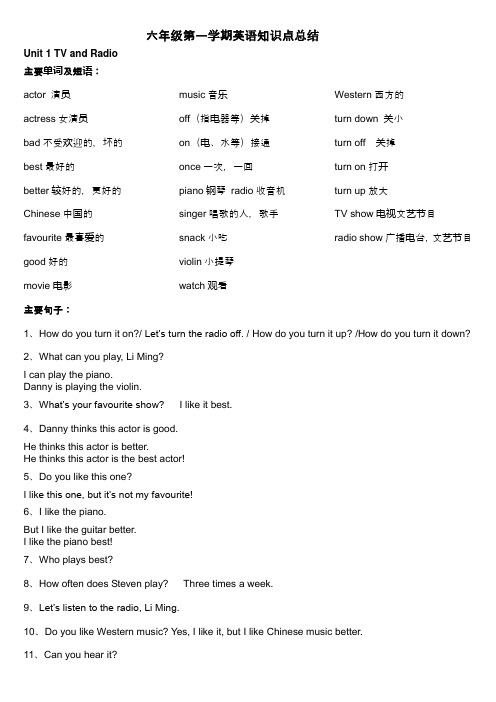
六年级第一学期英语知识点总结Unit 1 TV and Radio主要单词及短语:actor 演员actress女演员bad不受欢迎的,坏的best最好的better较好的,更好的Chinese中国的favourite最喜爱的good好的movie电影music音乐off(指电器等)关掉on(电、水等)接通once一次,一回piano钢琴radio收音机singer唱歌的人,歌手snack小吃violin小提琴watch观看Western西方的turn down 关小turn off 关掉turn on打开turn up放大TV show电视文艺节目radio show广播电台,文艺节目主要句子:1、How do you turn it on?/ Let’s turn the radio off. / How do you turn it up? /How do you turn it down?2、What can you play, Li Ming?I can play the piano.Danny is playing the violin.3、What’s your favourite show?I like it best.4、Danny thinks this actor is good.He thinks this actor is better.He thinks this actor is the best actor!5、Do you like this one?I like this one, but it’s not my favourite!6、I like the piano.But I like the guitar better.I like the piano best!7、Who plays best?8、How often does Steven play? Three times a week.9、Let’s listen to the radio, Li Ming.10、Do you like Western music? Yes, I like it, but I like Chinese music better.11、Can you hear it?12、Why is the radio playing Chinese music?13、Thanks for finding this radio show.14、Dinosaurs and people are different. I think dinosaurs and people are the same.15、What did you like best?I liked the dinosaur better than the rabbit, but I liked the snacks best.16、They order some food.17、Jenny wants Western food. “I would like a hamburger, French fries and milk, please.”18、I would like some Chinese food, please. I would like some noodles, dumplings and tea.19、There are many people at the restaurant.20、I can’t hear her. I can’t hear her either.重点语法复习:绝大多数形容词有三种形式,原级,比较级和最高级, 以表示形容词说明的性质在程度上的不同。
六年级上册英语知识点归纳

often经常 sometimes 有时候 never 从来不二、习惯语搭配:by bike/bus/plane/subway/train/ship/taxi/ferry骑自行车/乘公共汽车/飞机/地铁/火车/船/出租汽车/渡轮take the No.57 bus乘57路公 on foot步行slow down慢下来pay attention to注意 traffic lights 交通信号灯 look right向右看cross the road横穿马路 get off下车 at home在家 traffic rules交通规则 get to到达 get on 上车 be far from…表示离某地远三、惯用表达式:Wait!等一等! Hooray太好了!I see. 我明白了。
Go at a green light 绿灯行Stop at a red light 红灯停 Wait at a yellow light 黄灯等四、公式化句型:1、如何询问对方的出行方式:How do you come(to)+地点?你(们)怎么来···的?2、如何用must表示必须做某事:某人+must+动词原形(+其它). ···必须···。
3、告诫别人不要做某事的句型:Don’t +动词原形(+其它). .不要/别···。
五、例句:How do you go to school? 你怎么去上学?Usually I go to school on foot. Sometimes I go by bus.通常我步行去上学。
有时候骑自行车去。
How can I get to Zhongshan Park ? 我怎么到达中山公园?You can go by the No. 15 bus. 你可以坐15路公共汽车去。
六年级上册英语重要知识点

六年级上册英语重要知识点(20条)Unit 11. What an interesting film! 多么有趣的电影啊!【知识点一】记住感叹句的构成:What +a/an +形容词+可数名词单数!类似的还有:What a great museum! 多么好的博物馆啊!【知识点二】注意interesting是元音开头,它前面必须用冠词an2. It’s next to the bookstore.它挨着书店。
【知识点】next to,“挨着”,“紧挨着”,注意不能看成near to3. Is the Thames far from here? 泰晤士河离这儿远吗?【知识点】be far from…“离……远”It’s not far from here. 它离这儿不远。
Unit 24. I often go to school on foot. 我经常步行去上学。
【知识点】它的同义句是:I often walk to school.5.Take the No.57 bus over there.坐那边的57路公共汽车。
【知识点】take,动词,意思是“乘坐”。
take a bus,也是“乘公共汽车”,它动词短语,在句中做谓语。
而by bus是介词短语,在句中做状语,这是二者的区别。
I take a bus to the bookstore. 我乘公共汽车去书店。
I go to the bookstore by bus.我乘公共汽车去书店。
6. We must look right before crossing the road.过马路前我们必须向右看。
【知识点】注意crossing在此不是“十字路口”,而是动词cross(穿越,越过)的ing形式。
Unit 37. I’m going to have an art lesson.我要去上美术课。
【知识点】注意art是元音开头,前面的冠词必须用an8.Why not go on Tuesday? 为什么不星期二去呢?【知识点】why not“为什么不”,后面紧挨着的动词必须使用动词原形。
六年级上册英语知识点归纳
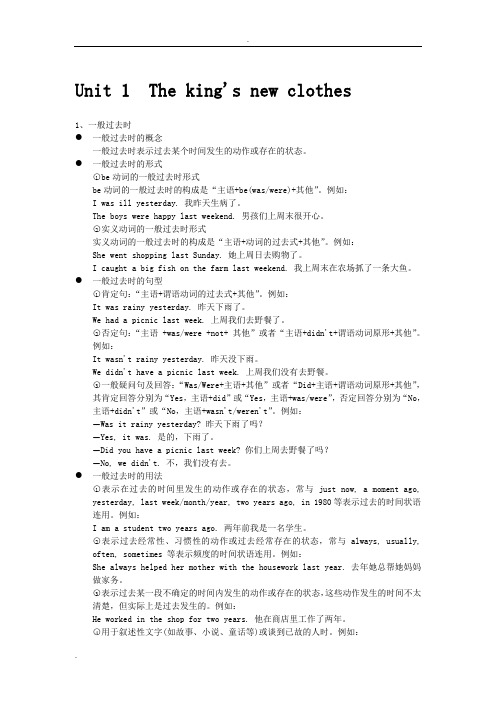
Unit 1 The king's new clothes1、一般过去时●一般过去时的概念一般过去时表示过去某个时间发生的动作或存在的状态。
●一般过去时的形式○1be动词的一般过去时形式be动词的一般过去时的构成是“主语+be(was/were)+其他”。
例如:I was ill yesterday. 我昨天生病了。
The boys were happy last weekend. 男孩们上周末很开心。
○2实义动词的一般过去时形式实义动词的一般过去时的构成是“主语+动词的过去式+其他”。
例如:She went shopping last Sunday. 她上周日去购物了。
I caught a big fish on the farm last weekend. 我上周末在农场抓了一条大鱼。
●一般过去时的句型○1肯定句:“主语+谓语动词的过去式+其他”。
例如:It was rainy yesterday. 昨天下雨了。
We had a picnic last week. 上周我们去野餐了。
○2否定句:“主语 +was/were +not+ 其他”或者“主语+didn't+谓语动词原形+其他”。
例如:It wasn't rainy yesterday. 昨天没下雨。
We didn't have a picnic last week. 上周我们没有去野餐。
○3一般疑问句及回答:“Was/Were+主语+其他”或者“Did+主语+谓语动词原形+其他”,其肯定回答分别为“Yes,主语+did”或“Yes,主语+was/were”,否定回答分别为“No,主语+didn't”或“No,主语+wasn't/weren't”。
例如:—Was it rainy yesterday? 昨天下雨了吗?—Yes, it was. 是的,下雨了。
—Did you have a picnic last week? 你们上周去野餐了吗?—No, we didn't. 不,我们没有去。
六年级英语上册知识点总汇

六年级英语上册知识点总汇一、介词与介词短语1. 常见介词介词是连接名词、代词或动词与其宾语之间关系的词语。
六年级上册中常见的介词有:in、on、at、to、from、for、with等。
2. 介词短语的用法介词短语由介词和其宾语构成,常用来表示时间、地点、原因、目的等。
例如:in the morning(在早晨)、at school(在学校)、from Monday to Friday(从星期一到星期五)等。
二、时态与语态1. 一般现在时一般现在时表示经常性、习惯性或普遍性的动作或状态。
句子结构为主语 + 动词原形,例如:She likes swimming.(她喜欢游泳。
)2. 一般过去时一般过去时表示过去发生的动作或状态。
句子结构为主语 + 动词过去式,例如:They visited the museum last week.(他们上周参观了博物馆。
)3. 一般将来时一般将来时表示将要发生的动作或状态。
句子结构为主语 + will + 动词原形,例如:I will go to the park tomorrow.(我明天将去公园。
)4. 被动语态被动语态表示主语是动作的承受者。
句子结构为主语 + be + 过去分词,例如:The book was written by Mark Twain.(这本书是马克·吐温写的。
)三、名词与数词1. 可数名词与不可数名词可数名词指可以计数的名词,可以有单数和复数形式;不可数名词则不能计数,只有单数形式。
例如:a pen(一支笔,可数名词)、water(水,不可数名词)等。
2. 名词所有格名词所有格表示所属关系,通常在名词后加's构成。
例如:Tom's book(汤姆的书)。
3. 基数词与序数词基数词表示数量或顺序,例如:one、two、three等;序数词表示顺序,例如:first、second、third等。
四、形容词与副词1. 形容词的比较级和最高级形容词的比较级表示两个事物之间的比较,结构为形容词 + er + than,例如:taller than(比...更高);最高级表示三个或三个以上事物中的最高级,结构为the + 形容词的最高级,例如:the tallest(最高的)。
六年级上册英语知识点归纳
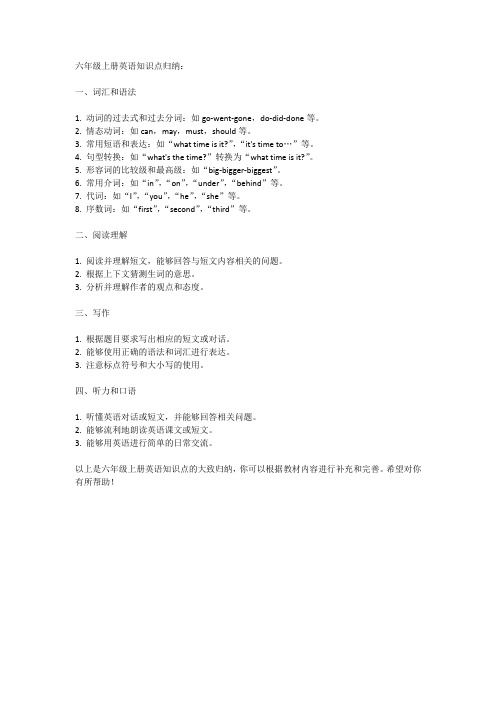
六年级上册英语知识点归纳:
一、词汇和语法
1. 动词的过去式和过去分词:如go-went-gone,do-did-done等。
2. 情态动词:如can,may,must,should等。
3. 常用短语和表达:如“what time is it?”,“it's time to…”等。
4. 句型转换:如“what's the time?”转换为“what time is it?”。
5. 形容词的比较级和最高级:如“big-bigger-biggest”。
6. 常用介词:如“in”,“on”,“under”,“behind”等。
7. 代词:如“I”,“you”,“he”,“she”等。
8. 序数词:如“first”,“second”,“third”等。
二、阅读理解
1. 阅读并理解短文,能够回答与短文内容相关的问题。
2. 根据上下文猜测生词的意思。
3. 分析并理解作者的观点和态度。
三、写作
1. 根据题目要求写出相应的短文或对话。
2. 能够使用正确的语法和词汇进行表达。
3. 注意标点符号和大小写的使用。
四、听力和口语
1. 听懂英语对话或短文,并能够回答相关问题。
2. 能够流利地朗读英语课文或短文。
3. 能够用英语进行简单的日常交流。
以上是六年级上册英语知识点的大致归纳,你可以根据教材内容进行补充和完善。
希望对你有所帮助!。
六年级上册英语全部知识点
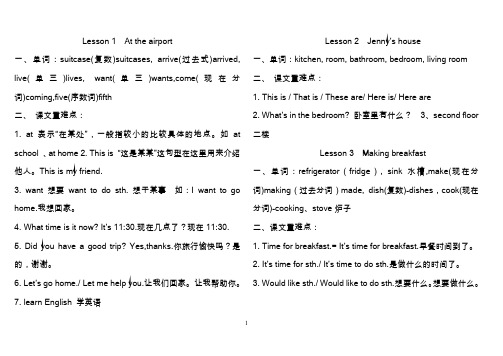
Lesson 1 At the airport一、单词:suitcase(复数)suitcases, arrive(过去式)arrived, live(单三)lives, want(单三)wants,come(现在分词)coming,five(序数词)fifth二、课文重难点:1. at表示“在某处”,一般指较小的比较具体的地点。
如at school 、at home2. This is “这是某某”这句型在这里用来介绍他人。
This is my friend.3. want 想要want to do sth. 想干某事如:I want to go home.我想回家。
4. What time is it now? It’s 11:30.现在几点了?现在11:30.5. Did you have a good trip? Yes,thanks.你旅行愉快吗?是的,谢谢。
6. Let’s go home./ Let me help you.让我们回家。
让我帮助你。
7. learn English 学英语Lesson 2 Jenny’s house一、单词:kitchen, room, bathroom, bedroom, living room二、课文重难点:1. This is / That is / These are/ Here is/ Here are2. What’s in the bedroom? 卧室里有什么?3、second floor 二楼Lesson 3 Making breakfast一、单词:refrigerator(fridge), sink水槽,make(现在分词)making(过去分词)made, dish(复数)-dishes,cook(现在分词)-cooking、stove炉子二、课文重难点:1. Time for breakfast.= It’s time for breakfast.早餐时间到了。
英语六年级上册必考知识点
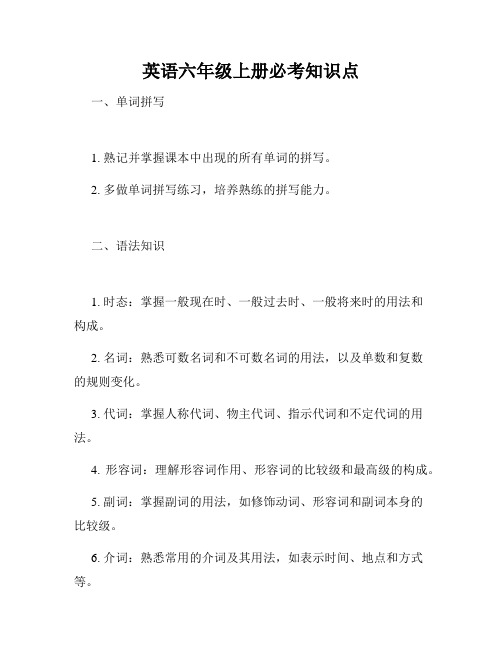
英语六年级上册必考知识点一、单词拼写1. 熟记并掌握课本中出现的所有单词的拼写。
2. 多做单词拼写练习,培养熟练的拼写能力。
二、语法知识1. 时态:掌握一般现在时、一般过去时、一般将来时的用法和构成。
2. 名词:熟悉可数名词和不可数名词的用法,以及单数和复数的规则变化。
3. 代词:掌握人称代词、物主代词、指示代词和不定代词的用法。
4. 形容词:理解形容词作用、形容词的比较级和最高级的构成。
5. 副词:掌握副词的用法,如修饰动词、形容词和副词本身的比较级。
6. 介词:熟悉常用的介词及其用法,如表示时间、地点和方式等。
7. 动词:了解动词的原形、过去式和过去分词的构成规则。
8. 人称代词和动词的一致性:掌握人称代词与动词之间的一致关系。
三、句型转换1. 肯定句转变为否定句和疑问句:掌握否定句和一般疑问句的构成规则。
2. 一般疑问句转变为肯定句和否定句:掌握回答一般疑问句的肯定和否定形式。
四、阅读理解1. 熟练阅读课本中的短文,并理解主旨内容。
2. 掌握从短文中获取关键信息的技巧,如寻找细节和推理等。
3. 培养阅读理解的速度和准确性,多做阅读练习。
五、写作能力1. 能够运用学到的基础词汇和语法知识,写出简单的句子和段落。
2. 培养表达思想的能力,逐渐提高写作的准确性和流畅性。
六、听力技巧1. 听力理解:提高听力的准确性和处理信息的能力。
2. 听写能力:提高听写的准确性和速度,注意拼写正确。
以上就是英语六年级上册必考的知识点汇总,希望同学们在备考过程中能够重点关注这些内容,加强基础,提高自身的英语水平。
祝大家取得好成绩!。
六年级英语(上学期)知识点归纳(仅供参考)
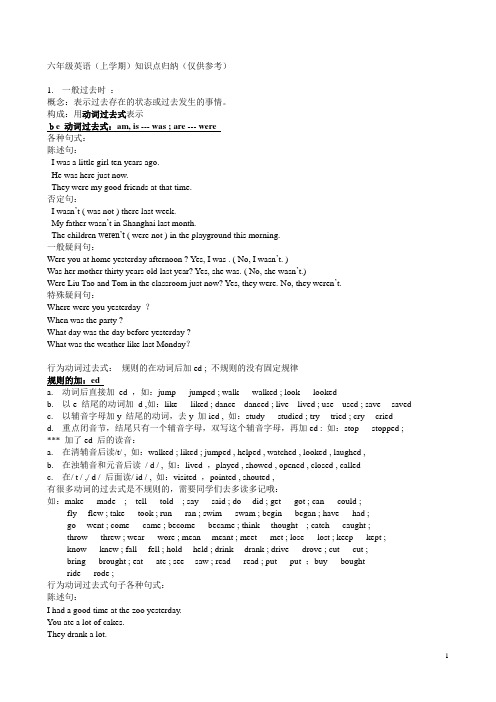
六年级英语(上学期)知识点归纳(仅供参考)1.一般过去时:概念:表示过去存在的状态或过去发生的事情。
构成:用动词过去式表示be 动词过去式:am, is --- was ; are --- were各种句式:陈述句:I was a little girl ten years ago.He was here just now.They were my good friends at that time.否定句:I wasn’t ( was not ) there last week.My father wasn’t in Shanghai last month.The children weren’t ( were not ) in the playground this morning.一般疑问句:Were you at home yesterday afternoon ? Yes, I was . ( No, I wasn’t. )Was her mother thirty years old last year? Yes, she was. ( No, she wasn’t.)Were Liu Tao and Tom in the classroom just now? Yes, they were. No, they weren’t.特殊疑问句:Where were you yesterday ?When was the party ?What day was the day before yesterday ?What was the weather like last Monday?行为动词过去式:规则的在动词后加ed ; 不规则的没有固定规律规则的加:eda.动词后直接加ed ,如:jump --- jumped ; walk --- walked ; look --- lookedb.以e 结尾的动词加d ,如:like --- liked ; dance---danced ; live---lived ; use---used ; save--- savedc.以辅音字母加y 结尾的动词,去y 加ied , 如:study --- studied ; try--- tried ; cry--- criedd.重点闭音节,结尾只有一个辅音字母,双写这个辅音字母,再加ed : 如:stop --- stopped ; *** 加了ed 后的读音:a.在清辅音后读/t/ , 如:walked ; liked ; jumped , helped , watched , looked , laughed ,b.在浊辅音和元音后读/ d / , 如:lived ,played , showed , opened , closed , calledc.在/ t / ,/ d / 后面读/ id / , 如:visited ,pointed , shouted ,有很多动词的过去式是不规则的,需要同学们去多读多记哦:如:make --- made ; tell --- told ; say --- said ; do--- did ; get --- got ; can --- could ;fly--- flew ; take --- took ; run --- ran ; swim --- swam ; begin --- began ; have --- had ;go--- went ; come --- came ; become --- became ; think--- thought ; catch --- caught ;throw --- threw ; wear --- wore ; mean--- meant ; meet --- met ; lose --- lost ; keep --- kept ;know --- knew ; fall--- fell ; hold--- held ; drink--- drank ; drive --- drove ; cut --- cut ;bring --- brought ; eat --- ate ; see--- saw ; read --- read ; put --- put ;buy --- boughtride --- rode ;行为动词过去式句子各种句式:陈述句:I had a good time at the zoo yesterday.You ate a lot of cakes.They drank a lot.否定句:I didn’t have a good time at the zoo yesterday.You didn’t eat a lot of cakes.They didn’t drink a lot.注意:在否定句中,由于前面出现了didn’t 这个助动词,后面的行为动词恢复了原形。
六年级上册英语一到四单元知识点
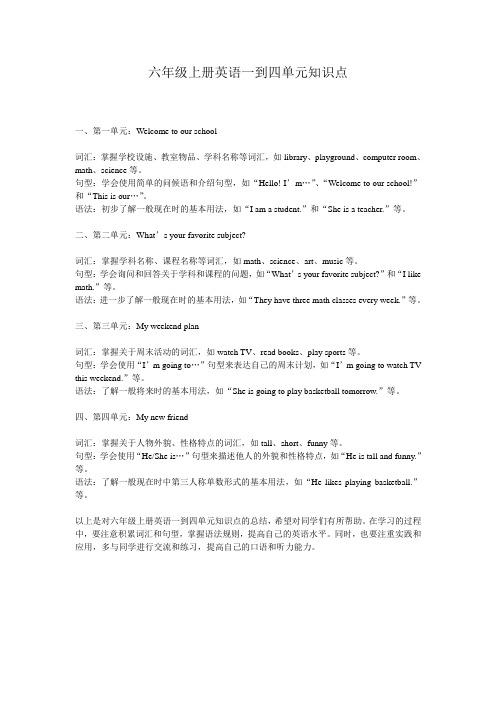
六年级上册英语一到四单元知识点一、第一单元:Welcome to our school词汇:掌握学校设施、教室物品、学科名称等词汇,如library、playground、computer room、math、science等。
句型:学会使用简单的问候语和介绍句型,如“Hello! I’m…”、“Welcome to our school!”和“This is our…”。
语法:初步了解一般现在时的基本用法,如“I am a student.”和“She is a teacher.”等。
二、第二单元:What’s your favorite subject?词汇:掌握学科名称、课程名称等词汇,如math、science、art、music等。
句型:学会询问和回答关于学科和课程的问题,如“What’s your favorite subject?”和“I like math.”等。
语法:进一步了解一般现在时的基本用法,如“They have three math classes every week.”等。
三、第三单元:My weekend plan词汇:掌握关于周末活动的词汇,如watch TV、read books、play sports等。
句型:学会使用“I’m going to…”句型来表达自己的周末计划,如“I’m going to watch TV this weekend.”等。
语法:了解一般将来时的基本用法,如“She is going to play basketball tomorrow.”等。
四、第四单元:My new friend词汇:掌握关于人物外貌、性格特点的词汇,如tall、short、funny等。
句型:学会使用“He/She is…”句型来描述他人的外貌和性格特点,如“He is tall and funny.”等。
语法:了解一般现在时中第三人称单数形式的基本用法,如“He likes playing basketball.”等。
语法英语六年级上册

语法英语六年级上册
六年级上册英语语法知识点
一、一般现在时
1. 肯定句形式:主语+动词原形+其他
2. 否定句形式:主语+don’t+动词原形+其他
3. 疑问句形式:Do+主语+动词原形+其他?
二、现在进行时
1. 肯定句形式:主语+be动词(am/is/are)+动词-ing+其他
2. 否定句形式:主语+be动词(am/is/are)+not+动词-ing+其他
3. 疑问句形式:Be动词(am/is/are)+主语+动词-ing+其他?
三、一般将来时
1. 肯定句形式:主语+will+动词原形+其他
2. 否定句形式:主语+won’t+动词原形+其他
3. 疑问句形式:Will+主语+动词原形+其他?
四、一般过去时
1. 肯定句形式:主语+动词过去式+其他
2. 否定句形式:主语+didn’t+动词原形+其他
3. 疑问句形式:Did+主语+动词原形+其他?。
六年级上册英语必备知识点
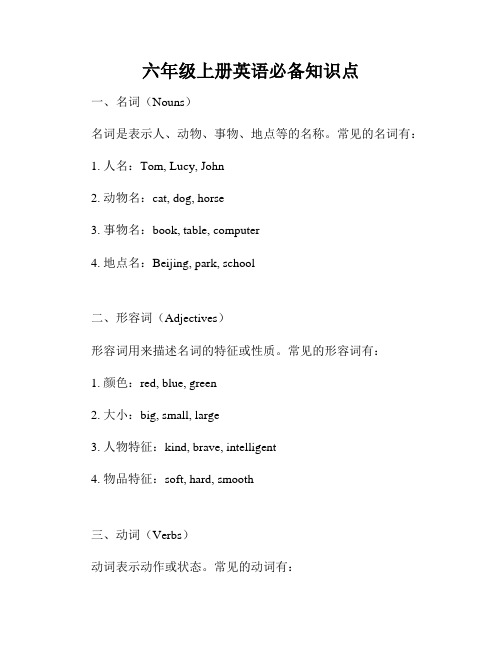
六年级上册英语必备知识点一、名词(Nouns)名词是表示人、动物、事物、地点等的名称。
常见的名词有:1. 人名:Tom, Lucy, John2. 动物名:cat, dog, horse3. 事物名:book, table, computer4. 地点名:Beijing, park, school二、形容词(Adjectives)形容词用来描述名词的特征或性质。
常见的形容词有:1. 颜色:red, blue, green2. 大小:big, small, large3. 人物特征:kind, brave, intelligent4. 物品特征:soft, hard, smooth三、动词(Verbs)动词表示动作或状态。
常见的动词有:1. 动作动词:run, jump, swim2. 状态动词:be, feel, think3. 助动词:can, will, should四、副词(Adverbs)副词用来修饰动词、形容词和其他副词,表示时间、地点、方式等。
常见的副词有:1. 时间副词:today, soon, never2. 地点副词:here, there, everywhere3. 方式副词:slowly, quickly, carefully五、介词(Prepositions)介词用来描述名词与其他词之间的关系,表示时间、地点、方式等。
常见的介词有:1. 时间介词:at, on, in2. 地点介词:beside, near, behind3. 方式介词:with, by, through六、代词(Pronouns)代词可以替代名词,在句子中起到指代作用。
常见的代词有:1. 人称代词:I, you, he2. 物主代词:my, your, his3. 指示代词:this, that, these4. 不定代词:some, any, all七、冠词(Articles)冠词用来修饰名词,表示特指或泛指。
六年级上册英语的知识点
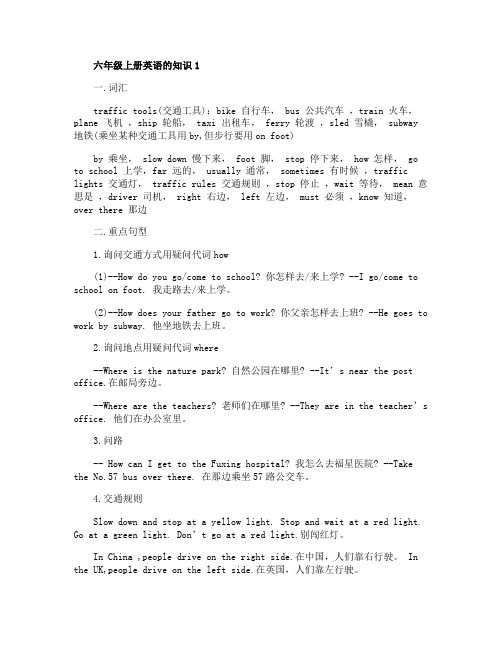
六年级上册英语的知识1一.词汇traffic tools(交通工具):bike 自行车, bus 公共汽车,train 火车,plane 飞机,ship 轮船, taxi 出租车, ferry 轮渡,sled 雪橇, subway 地铁(乘坐某种交通工具用by,但步行要用on foot)by 乘坐, slow down 慢下来, foot 脚, stop 停下来, how 怎样, go to school 上学,far 远的, usually 通常, sometimes 有时候,traffic lights 交通灯, traffic rules 交通规则,stop 停止,wait 等待, mean 意思是,driver 司机, right 右边, left 左边, must 必须,know 知道,over there 那边二.重点句型1.询问交通方式用疑问代词how(1)--How do you go/come to school? 你怎样去/来上学? --I go/come to school on foot. 我走路去/来上学。
(2)--How does your father go to work? 你父亲怎样去上班? --He goes to work by subway. 他坐地铁去上班。
2.询问地点用疑问代词where--Where is the nature park? 自然公园在哪里? --It’s near the post office.在邮局旁边。
--Where are the teachers? 老师们在哪里? --They are in the teacher’s office. 他们在办公室里。
3.问路-- How can I get to the Fuxing hospital? 我怎么去福星医院? --Take the No.57 bus over there. 在那边乘坐57路公交车。
英语六年级上学期知识点
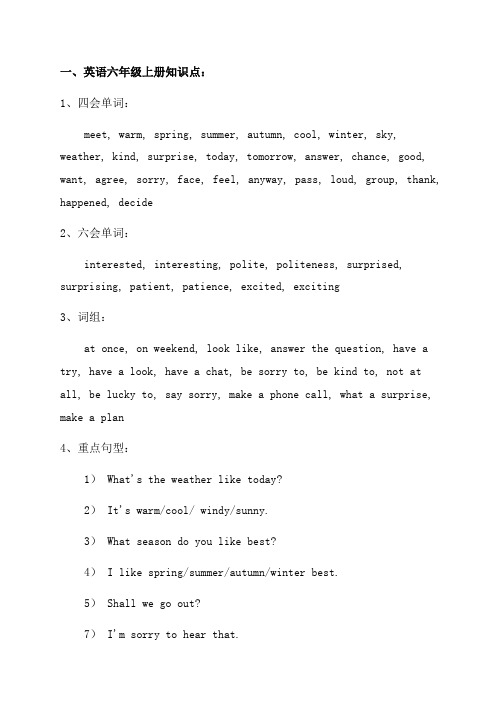
一、英语六年级上册知识点:1、四会单词:meet, warm, spring, summer, autumn, cool, winter, sky, weather, kind, surprise, today, tomorrow, answer, chance, good, want, agree, sorry, face, feel, anyway, pass, loud, group, thank, happened, decide2、六会单词:interested, interesting, polite, politeness, surprised, surprising, patient, patience, excited, exciting3、词组:at once, on weekend, look like, answer the question, have a try, have a look, have a chat, be sorry to, be kind to, not at all, be lucky to, say sorry, make a phone call, what a surprise, make a plan4、重点句型:1) What's the weather like today?2) It's warm/cool/ windy/sunny.3) What season do you like best?4) I like spring/summer/autumn/winter best.5) Shall we go out?7) I'm sorry to hear that.9) I'd love to.10) I agree with you.11) I disagree with you.12) What happened?13) Would you like to join us?14) I'm sorry, I can't.15) I'd like to have a try.16) It sounds exciting.17) What a surprise!18) Let's decide together.19) Let's make a plan.20) Shall we have a chat?二、六年级上册语法知识:1、紧缩形式:I'm = I amShe's = She isHe's = He isYou're = You are2、疑问句:Shall we go? 咱们去吗?Would you like to join us? 你想加入我们吗?What's the weather like today? 今天天气怎么样?What season do you like best? 你最喜欢哪个季节?3、情态动词:Can 能;可以Must 必须Mustn't 不可以Should 应该Shouldn't 不该4、动词的时态:一般现在时:表示动作发生的经常性或习惯一般过去时:表示动作已经发生以及有的结果5、There be 句型:There is a lake in the park. 公园里有一个湖There are many flowers in the garden. 花园里有许多花6、代词:I我You 你,你们He他She 她It它We我们They 他们7、祈使句:Let's go! 咱们走吧!Let's make a plan. 咱们来制定一个计划吧。
(完整)六年级上册英语知识整理
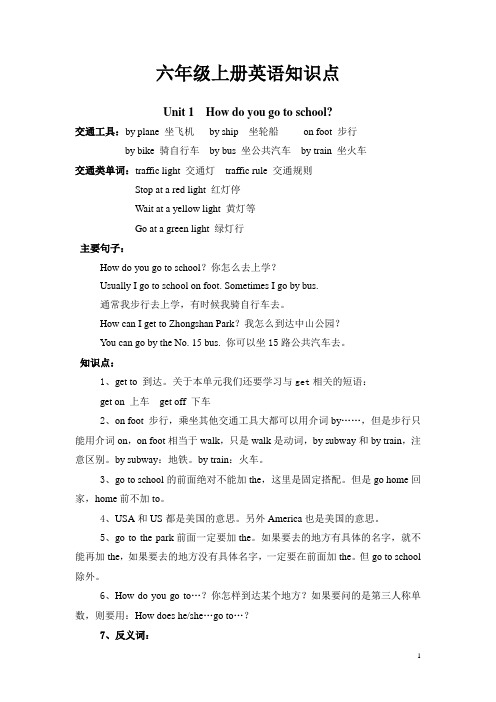
六年级上册英语知识点Unit 1 How do you go to school?交通工具:by plane坐飞机by ship 坐轮船on foot步行by bike骑自行车by bus坐公共汽车by train坐火车交通类单词:traffic light交通灯traffic rule交通规则Stop at a red light红灯停Wait at a yellow light黄灯等Go at a green light绿灯行主要句子:How do you go to school?你怎么去上学?Usually I go to school on foot. Sometimes I go by bus.通常我步行去上学,有时候我骑自行车去。
How can I get to Zhongshan Park?我怎么到达中山公园?You can go by the No. 15 bus.你可以坐15路公共汽车去。
知识点:1、get to到达。
关于本单元我们还要学习与get相关的短语:get on上车get off 下车2、on foot步行,乘坐其他交通工具大都可以用介词by……,但是步行只能用介词on,on foot相当于walk,只是walk是动词,by subway和by train,注意区别。
by subway:地铁。
by train:火车。
3、go to school的前面绝对不能加the,这里是固定搭配。
但是go home回家,home前不加to。
4、USA和US都是美国的意思。
另外America也是美国的意思。
5、go to the park前面一定要加the。
如果要去的地方有具体的名字,就不能再加the,如果要去的地方没有具体名字,一定要在前面加the。
但go to school 除外。
6、How do you go to…?你怎样到达某个地方?如果要问的是第三人称单数,则要用:How does he/she…go to…?7、反义词:get on(上车)—get off(下车)near(近的)—far(远的)fast(快的)—slow(慢的)same(相同的)—different(不同的)。
六年级上英语知识点归纳总结
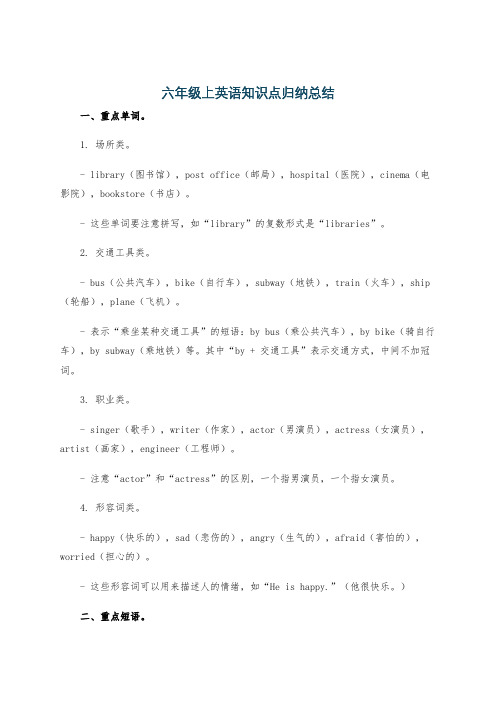
六年级上英语知识点归纳总结一、重点单词。
1. 场所类。
- library(图书馆),post office(邮局),hospital(医院),cinema(电影院),bookstore(书店)。
- 这些单词要注意拼写,如“library”的复数形式是“libraries”。
2. 交通工具类。
- bus(公共汽车),bike(自行车),subway(地铁),train(火车),ship (轮船),plane(飞机)。
- 表示“乘坐某种交通工具”的短语:by bus(乘公共汽车),by bike(骑自行车),by subway(乘地铁)等。
其中“by + 交通工具”表示交通方式,中间不加冠词。
3. 职业类。
- singer(歌手),writer(作家),actor(男演员),actress(女演员),artist(画家),engineer(工程师)。
- 注意“actor”和“actress”的区别,一个指男演员,一个指女演员。
4. 形容词类。
- happy(快乐的),sad(悲伤的),angry(生气的),afraid(害怕的),worried(担心的)。
- 这些形容词可以用来描述人的情绪,如“He is happy.”(他很快乐。
)二、重点短语。
1. 问路相关。
- turn left(向左转),turn right(向右转),go straight(直走)。
- 例如:“Go straight and then turn left at the second crossing.”(直走然后在第二个十字路口左转。
)2. 兴趣爱好相关。
- read books(读书),see a film(看电影),take a trip(去旅行),go hiking(去远足)。
- 例如:“I like to read books on weekends.”(我喜欢在周末读书。
)三、重点句型。
1. 询问地点。
- Where is the + 地点?例如:“Where is the post office?”(邮局在哪里?)- 回答:It's + 方位介词短语。
六年级上册英语常用知识点
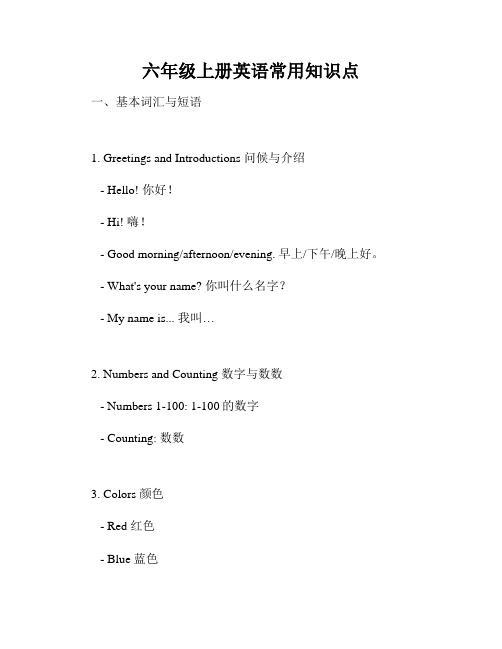
六年级上册英语常用知识点一、基本词汇与短语1. Greetings and Introductions 问候与介绍- Hello! 你好!- Hi! 嗨!- Good morning/afternoon/evening. 早上/下午/晚上好。
- What's your name? 你叫什么名字?- My name is... 我叫…2. Numbers and Counting 数字与数数- Numbers 1-100: 1-100的数字- Counting: 数数3. Colors 颜色- Red 红色- Blue 蓝色- Green 绿色- Yellow 黄色- Orange 橙色- Purple 紫色4. Days of the Week and Months of the Year 星期与月份 - Days of the Week: 星期- Months of the Year: 月份5. Family 家庭- Mother 母亲- Father 父亲- Sister 姐妹- Brother 兄弟二、基本语法1. Simple Present Tense 现在简单时- Affirmative, Negative, and Interrogative sentences: 肯定句、否定句、疑问句- Third person singular: 第三人称单数2. Present Continuous Tense 现在进行时- Affirmative, Negative, and Interrogative sentences: 肯定句、否定句、疑问句3. Question Words 疑问词- Who? 谁?- What? 什么?- When? 什么时候?- Where? 在哪里?- Why? 为什么?- How? 如何?4. Prepositions 介词- In, On, Under, Next to, Between: 在…里,在…上,在…下,在…旁边,在…之间三、日常用语与交际技巧1. Asking for Help 请求帮助- Could you please help me? 你能帮个忙吗?- Can you show me...? 你能给我看看…吗?- I need your assistance. 我需要你的帮助。
六年级英语上册知识点汇总
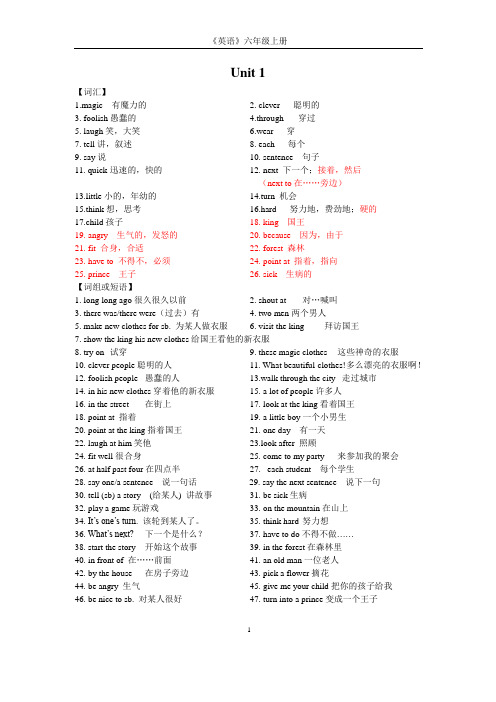
Unit 1【词汇】1.magic 有魔力的2. clever 聪明的3. foolish愚蠢的4.through 穿过5. laugh笑,大笑6.wear 穿7. tell讲,叙述8. each 每个9. say说10. sentence 句子11. quick 迅速的,快的12. next 下一个;接着,然后(next to在……旁边)13.little小的,年幼的14.turn 机会15.think想,思考16.hard 努力地,费劲地;硬的17.child孩子18. king 国王19. angry 生气的,发怒的20. because 因为,由于21. fit 合身,合适22. forest 森林23. have to 不得不,必须24. point at 指着,指向25. prince 王子26. sick 生病的【词组或短语】1. long long ago很久很久以前2. shout at 对…喊叫3. there was/there were(过去)有4. two men两个男人5. make new clothes for sb. 为某人做衣服6. visit the king 拜访国王7. show the king his new clothes给国王看他的新衣服8. try on 试穿9. these magic clothes 这些神奇的衣服10. clever people聪明的人11. What beautiful clothes!多么漂亮的衣服啊!12. foolish people 愚蠢的人13.walk through the city 走过城市14. in his new clothes穿着他的新衣服15. a lot of people许多人16. in the street 在街上17. look at the king看着国王18. point at 指着19. a little boy一个小男生20. point at the king指着国王21. one day 有一天22. laugh at him笑他23.look after 照顾24. fit well很合身25. come to my party 来参加我的聚会26. at half past four在四点半27. each student 每个学生28. say one/a sentence 说一句话29. say the next sentence 说下一句30. tell (sb) a story (给某人) 讲故事31. be sick生病32. play a game玩游戏33. on the mountain在山上34. It’s one’s turn.该轮到某人了。
- 1、下载文档前请自行甄别文档内容的完整性,平台不提供额外的编辑、内容补充、找答案等附加服务。
- 2、"仅部分预览"的文档,不可在线预览部分如存在完整性等问题,可反馈申请退款(可完整预览的文档不适用该条件!)。
- 3、如文档侵犯您的权益,请联系客服反馈,我们会尽快为您处理(人工客服工作时间:9:00-18:30)。
六年级上册知识点Unit 1 How do you go to school?主要单词:by plane 坐飞机 by ship 坐轮船 on foot步行 by bike 骑自行车 by bus 坐公共汽车 by train 坐火车 traffic lights 交通灯 traffic rules交通规则 Stop at a red light 红灯停 Wait at a yellow light 黄灯等 Go at a green light 绿灯行主要句子:How do you go to school?你怎么去上学?Usually I go to school on foot. Sometimes I go by bus.通常我步行去上学。
有时候骑自行车去。
How can I get to Zhongshan Park ?我怎么到达中山公园?You can go by the No. 15 bus.你可以坐15路公共汽车去。
知识点:1、There are many ways to go somewhere.到一个地方去有许多方法。
这里的ways一定要用复数。
因为there are是There be句型的复数形式。
2、get to到达.关本单元我们还要学习与get相关的短语:get on 上车 get off下车3、on foot 步行乘坐其他交通工具大都可以用介词by…, 但是步行只能用介词on 。
4、go to school的前面绝对不能加the,这里是固定搭配。
5、USA 和 US 都是美国的意思。
另外America 也是美国的意思。
6 go to the park前面一定要加the.如果要去的地方有具体的名字,就不能再加the , 如果要去的地方没有具体名字,由要在前面加the. go to school 除外。
7、How do you go to …?你怎样到达某个地方?如果要问的是第三人称单数,则要用:How doeshe/she…go to …?8、反义词:get on(上车)---get off(下车) near(近的)—far(远的) fast(快的)—slow(慢的) because(因为)—why(为什么)same(相同的)—different(不同的)9、近义词:seeyou---goodbye sure---certainly---of course10、频度副词:always 总是,一直 usually 通常 often经常 sometimes 有时候 never 从来不Unit 2 Where is the science museum?主要单词:library 图书馆 post office 邮局 hospital医院 cinema 电影院 bookstore书店 science museum科学博物馆 turn left向左转 turn right 向右转 go straight 直行 north北 south南 east东 west西主要句子:Where is the cinema, please? 请问电影院在哪里?It’s next to the hospital. 它与医院相邻。
Turn left at the cinema, then go straight. It’s on the left.在电影院向左转,然后直行。
它在左边。
知识点:1、near 表示在附近,next to 表示与…相邻。
它的范围比near小。
2、电影院在英语中称为“cinema”,在美语中称为movie theatre.3、for 表示持续多长时间,当表示做某事多长时间都要用for. 如:Walk east for 5 minutes.4、当表示某个地方在另一个地方的哪一方向时,要用介词of。
如:the hospital is east the cinema. 医院在电影院的东边。
5、表示在哪儿转时,用介词at。
如:Turn left at the bank。
在银行左转。
6、find表示“找到”,强调找的结果。
Look for 表示“寻找”,强调找的过程。
7、英文的书信与中文的书信不完全一样:开头:英语是在人称后面加逗号,中文是加冒号。
正文:英语是顶格写,中文要空两个格。
结尾:英语的落款与人名是顶格而且是分开写的。
中文则是另起一行,放在一起且稍靠后一点儿的地方。
8、近义词:bookstore==bookshop 书店 gostraight==go down直行after school==after class 放学后9、反义词或对应词:here (这里)---there(那里)east(东)---west(西) north(北)---south(南)left(左)---right(右) get on (上车)---get off(下车)10、in the front of…表示在…的前面,是指在该地方的范围内,in front of而则表示在该地方的范围外。
如:in front of our classroom是指在教室的外面而且在教室的前面。
而in the front of classroom则是指在教室里的前面。
11. be far from…表示离某地远. be 可以是am , is ,are。
如:I am far from school now. 我现在离学校很远。
My home is not far from school.我家离学校不远。
Unit 3 What are you going to do ?主要单词:this morning 今天上午 this afternoon 今天下午this evening 今天晚上 next week 下周tomorrow 明天 tonight 今晚post card 明信片 comic book漫画书newspaper报纸主要句子:What are you going to do on the weekend?你周末打算做什么?I’m going to visit my g randparents this weekend?这个周末我打算去看望我的外祖父母。
Where are you going this afternoon? 你今天下午打算去哪里?I’m going to the bookstore.我打算去书店。
What are you going to buy?你打算去买什么?I’m going to buy a comic book。
我打算去买一本漫画书。
知识点:1、What are you going to do?你想做什么?询问他人在未来的打算。
Be going to 后面要跟动词的原形。
2、this evening 和 tonight的区别:this evening指的是今天晚上睡觉以前的时间,一般指晚上十二点以前。
而tonight指的是今晚,一般是指一整晚的时间,通宵。
3、部分疑问代词的意义与用法:(1)What 什么。
用来问是什么,做什么,叫什么,什么样等等。
如:What is your name? 你的名字叫什么?What is your father? 你爸爸是干什么的?What is your hobby?你的爱好是什么?What is your favourite food?你最喜爱的食物是什么?What’s your math teacher like? 你的数学老师长得什么样子?(2)Where , 在哪里,到哪里。
用来问地点。
如:Where are you from?你从哪里来?Where are you going to ?你打算去哪里?Where is my ruler?我的尺子在哪里?(3)When,什么时候。
用来问时间。
如:When is your birthday? 你的生日是什么时候?When are you going to ?你打算什么时候去?When do you go to school?你什么时候去上学?(4)what time 几点了。
用来问具体的时间,如:What time is it? 现在几点了?(5)What colour什么颜色。
用来问物体的颜色。
如:What colour is your schoolbag?你的书包是什么颜色的?(6)What kind of 什么种类。
用来问类别。
如What kind of fruit do you like?你最喜欢哪一种水果?(7)who谁。
用来问人物是谁。
如:Who is your English teacher ?你的英语老师是谁?Who’s that man? 那个男人是谁?(8) whose谁的。
用来问物体的主人是谁?如:Whose pencil is this? 这是谁的铅笔?Whose bike is blue? 谁的自行车是蓝色的?(9) which哪一个。
用来问具体的哪一个。
如:Which season do you like best?你最喜欢哪个季节?Which pencil is ken’s? the long one or the short one?哪只铅笔是Ken的?长的那支还是短的那支?(10)how怎样?用来问身体状况,或者事情的状况,对事件的看法等。
如:How are you?你好吗?How is your mother? 你妈妈好吗?How about you? 你呢?(11)how many多少个。
用来问有多少个,后面要跟名词的复数形式。
如:How many books do you have?你有多少本书?How many kites can you see? 你能看见多少只风筝?(12) how much 多少钱。
用来问物体的价钱。
如:How much are they? 他们多少钱?How much is your schoolbag? 你的书包多少钱?(13)how old 几岁了。
用来问年龄。
如How old are you ? 你几岁了?How old is your father? 你爸爸多大了?(14)why为什么。
用来问原因,一般要用because 来回答。
如:why do you like spring?你为什么喜欢春天?Because I can fly kites.国为我可以放风筝。
(15) how long 多长(16)how tall 多高4、I want to be…我想成为… 表示理想。
Unit 4 I have pen pal1、动词变为动名词的规则:动词变为动名词,即是动词加ing。
